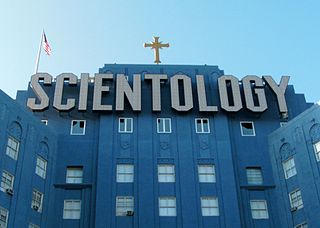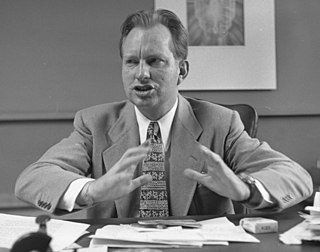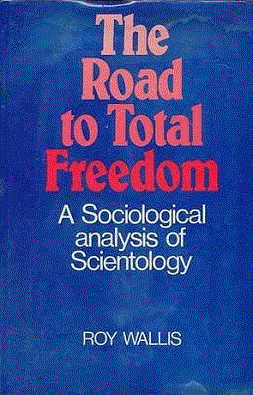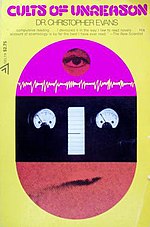
Dianetics is a set of pseudoscientific ideas and practices regarding the metaphysical relationship between the mind and body created by science fiction writer and Scientology founder L. Ron Hubbard. Dianetics is practiced by followers of Scientology and the Nation of Islam.

Lafayette Ronald Hubbard was an American author and the founder of Scientology. A prolific writer of pulp science fiction and fantasy novels in his early career, in 1950 he authored Dianetics: The Modern Science of Mental Health and established organizations to promote and practice Dianetics techniques. Hubbard created Scientology in 1952 after losing the rights to Dianetics in bankruptcy proceedings, and would manage the Church of Scientology until his death in 1986. Born in Tilden, Nebraska, in 1911, Hubbard spent much of his childhood in Helena, Montana. While his father was posted to the U.S. naval base on Guam in the late 1920s, Hubbard traveled to Asia and the South Pacific. In 1930, Hubbard enrolled at George Washington University to study civil engineering but dropped out in his second year. He began his career as a prolific writer of pulp fiction stories and married Margaret Grubb, who shared his interest in aviation.

Xenu, also called Xemu, is a figure in the Church of Scientology's secret "Advanced Technology", a sacred and esoteric teaching. According to the "Technology", Xenu was the extraterrestrial ruler of a "Galactic Confederacy" who brought billions of his people to Earth in DC-8-like spacecraft 75 million years ago, stacked them around volcanoes, and killed them with hydrogen bombs. Official Scientology scriptures hold that the thetans of these aliens adhere to humans, causing spiritual harm.

The Church of Scientology maintains a wide variety of beliefs and practices. The core belief holds that a human is an immortal, spiritual being (thetan) that is resident in a physical body. The thetan has had innumerable past lives, some of which, preceding the thetan's arrival on Earth, were lived in extraterrestrial cultures. Based on case studies at advanced levels, it is predicted that any Scientologist undergoing auditing will eventually come across and recount a common series of past-life events.

In Scientology, the concept of the thetan is similar to the concept of self, or the spirit or soul as found in several belief systems. The term is derived from the Greek letter Θ, theta, which in Scientology beliefs represents "the source of life, or life itself." In Scientology it is believed that it is the thetan, not the central nervous system, which commands the body.

The E-meter, originally the electropsychometer, is an electronic device for displaying the electrodermal activity (EDA) of a human being. It is used for auditing in Scientology and divergent groups. The efficacy and legitimacy of Scientology's use of the E-meter has been subject to extensive litigation and in accordance with a federal court order, the Church of Scientology publishes disclaimers declaring that the E-meter "by itself does nothing", is incapable of improving health, and is used specifically for spiritual purposes.
The reactive mind is a concept in the Scientology religion formulated by L. Ron Hubbard, referring to that portion of the human mind that is unconscious and operates on stimulus-response, to which Hubbard attributed most mental, emotional, and psychosomatic ailments:
What can it do? It can give a man arthritis, bursitis, asthma, allergies, sinusitis, coronary trouble, high blood pressure and so on, down the whole catalog of psychosomatic ills, adding a few more which were never specifically classified as psychosomatic, such as the common cold.

Dianetics: The Modern Science of Mental Health, sometimes abbreviated as DMSMH, is a book by L. Ron Hubbard about Dianetics, a system that he developed from a combination of personal experience, basic principles of Eastern philosophy and the work of Sigmund Freud, the founder of psychoanalysis. The book is a canonical text of Scientology. It’s colloquially referred to as Book One. The book launched the movement, which later defined itself as a religion, in 1950. As of 2013, New Era Publications, the international publishing company of Hubbard's works, sells the book in English and in 50 other languages.

Scientology founder L. Ron Hubbard explicitly compared his teachings to the science-fiction subgenre space opera. In his writings, wherein thetans were reincarnated periodically over quadrillions of years, retaining memories of prior lives, to which Hubbard attributed complex narratives about life throughout the universe. The most controversial of these myths is the story of Xenu, to whom Hubbard attributed responsibility for many of the world's problems.

Science of Survival is a 1951 book by L. Ron Hubbard, extending his earlier writings on Dianetics. Its original subtitle was "simplified, faster dianetic techniques", although more recent editions have the subtitle "Prediction of human behavior". It is one of the canonical texts of Scientology.
A UFO religion is any religion in which the existence of extraterrestrial (ET) entities operating unidentified flying objects (UFOs) is an element of belief. Typically, adherents of such religions believe the ETs to be interested in the welfare of humanity which either already is, or eventually will become, part of a pre-existing ET civilization. Other religions predate the UFO era of the mid 20th century, but incorporate ETs into a more supernatural worldview in which the UFO occupants are more akin to angels than physical aliens, but this distinction may be blurred within the overall subculture. These religions have their roots in the tropes of early science fiction and weird fiction writings, in ufology, and in the subculture of UFO sightings and alien abduction stories. Historians have considered the Aetherius Society, founded by George King, to be the first UFO religion.

History of Dianetics and Scientology begins around 1950. During the late 1940s, L. Ron Hubbard began developing a mental therapy system which he called Dianetics. Hubbard had tried to interest the medical profession in his techniques, including the Gerontological Society, the Journal of the American Medical Association, and the American Journal of Psychiatry, but his work was rejected for not containing sufficient evidence of efficacy to be acceptable.
Para-Scientology is a branch of Scientology which deals with all things unknown.

This is a Timeline of Scientology, particularly its foundation and development by author L. Ron Hubbard as well as general publications, articles, books and other milestones.
The Church of Scientology publicly classifies itself as a religion, but scholars and other observers regard it as a business, because the organization operates more like a for-profit business than a religious institution. Some scholars of sociology working in religious studies consider it a new religious movement. Overall, as stated by Stephen A. Kent, Scientology can be seen as a "multi-faceted transnational corporation that has religion as only one of its many components. Other components include political aspirations, business ventures, cultural productions, pseudo-medical practices, pseudo-psychiatric claims, and, an alternative family structure."

The relationship between Scientology and religious groups is very complex. While Scientology claims that it is fully compatible with all existing major world religions and that it does not conflict with them or their religious practices, there are significant contradictions between Scientology and most religions, especially the major monotheistic religions. Members are not allowed to engage in other similar mental therapies or procedures, religious or otherwise.

Scientology is a set of beliefs and practices invented by the American author L. Ron Hubbard, and an associated movement. It is variously defined as a cult, a business, or a new religious movement. Hubbard initially developed a set of ideas that he called Dianetics, which he represented as a form of therapy. An organization that he established in 1950 to promote it went bankrupt, and Hubbard lost the rights to his book Dianetics in 1952. He then recharacterized his ideas as a religion, likely for tax purposes, and renamed them Scientology. By 1954 he had regained the rights to Dianetics and founded the Church of Scientology, which remains the largest organization promoting Scientology. There are practitioners independent of the Church, in what is called the Free Zone. Estimates put the number of Scientologists at under 40,000 worldwide.

The Road to Total Freedom: A Sociological Analysis of Scientology is a non-fiction book about Scientology by sociologist Roy Wallis. Originally published in 1976 by Heinemann, it was republished in 1977 by Columbia University Press. The original manuscript was the product of Wallis's doctoral research at Oxford under the tutelage of Bryan Wilson. Wallis, after a review of the original manuscript by Scientology leaders, made edits to about 100 passages before publication.
This is a bibliography of books critical of Scientology and the Church of Scientology, sorted by alphabetical order of titles.






